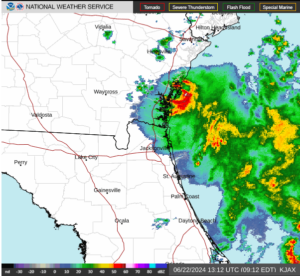Hurricane Beryl strengthened to Category 4 on the Saffir-Simpson Scale on Sunday morning. At 11:30 a.m. EDT on Sunday the center of Hurricane Beryl was located at latitude 10.8°N and longitude 54.9°W which put the center about 350 miles (565 km) east-southeast of Barbados. Beryl was moving toward the west at 21 m.p.h. (33 km/h). The maximum sustained wind speed was 130 m.p.h. (210 km/h) and there were wind gusts to 160 m.p.h. (260 km/h). The minimum surface pressure was 962 mb.
Hurricane Warnings were in effect for Barbados, St. Lucia, Grenada, Tobago, and St. Vincent and the Grenadine Islands.
A Tropical Storm Warning was in effect for Martinique.
Tropical Storm Watches were in effect for Dominica and Trinidad.
A U.S. Air Force Reserve Hurricane Hunter aircraft found that Hurricane Beryl had rapidly intensified on Sunday morning to Category 4 on the Saffir-Simpson Scale.
A circular eye with a diameter of 18 miles (30 km) was present at the center of Beryl’s circulation. The eye was surrounded by a ring of thunderstorms and the strongest winds were occurring in that ring of storms. Bands of showers and thunderstorms were revolving around the core of Hurricane Beryl. Storms near the core generated strong upper level divergence that pumped mass away from the hurricane in all directions. The removal of large amounts of mass caused the surface pressure to decrease rapidly.
The reconnaissance aircraft also found that the size of the circulation around Hurricane Beryl increased when Beryl rapidly intensified. Winds to hurricane force extended out 30 miles (50 km) from the center of Beryl’s circulation. Winds to tropical storm force extended out 115 miles (185 km) from the center of Hurricane Beryl.
Hurricane Beryl will move through an environment favorable for intensification during the next 24 hours. Beryl will move over water where the Sea Surface Temperatures are near 29°C. It will move under the southern part of an upper level ridge over the central tropical Atlantic Ocean. The ridge will produce easterly winds that will blow toward the top of Beryl’s circulation. The winds in the lower levels of the atmosphere are also blowing from the east and there will be little vertical wind shear. Hurricane Beryl is likely to continue to intensify during the next 24 hours. Beryl could continue to intensify rapidly during the next few hours. There is a chance Hurricane Beryl could strengthen to Category 5 on the Saffir-Simpson Scale.
Hurricane Beryl will move around the southern side of a high pressure system over the Atlantic Ocean. The high pressure system will steer Beryl toward the west during the next 24 hours. On its anticipated track, Tropical Storm Beryl will move quickly toward the Windward Islands. Beryl will approach Barbados and Tobago by Sunday night. Hurricane Beryl will affect St. Lucia, Grenada, St. Vincent and the Grenadine Islands, and Martinique on Monday.
The core of Hurricane Beryl could pass very close to Grenada and St. Vincent and the Grenadine Islands. Beryl will be capable of causing regional severe damage. Hurricane Beryl will also drop heavy rain. Heavy rain is likely to cause flash floods in some locations. Hurricane Beryl could cause a storm surge of up to 13 feet (4 meters) on the parts of islands where the wind blows the water toward the shore.
Hurricane Beryl will also produce strong winds and heavy rain in Barbados, Tobago, St. Lucia and Martinique. Gusty winds and heavy rain could occur in Trinidad and Dominica.

